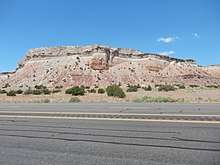Todilto Formation
The Todilto Formation is a geologic formation in northern New Mexico and southeastern Colorado. It preserves fossils dating back to the Callovian stage of the middle Jurassic period.
| Todilto Formation Stratigraphic range: Callovian | |
|---|---|
 Small hill capped with gypsum beds of the Todilto Formation | |
| Type | Formation |
| Sub-units | Luciano Mesa Member, Tonque Arroyo Member |
| Underlies | Summerville Formation |
| Overlies | Entrada Formation |
| Thickness | 70 m (230 ft) |
| Lithology | |
| Primary | Gypsum |
| Other | Calcareous shale |
| Location | |
| Coordinates | 35.911°N 108.956°W |
| Region | New Mexico |
| Country | United States |
| Type section | |
| Named for | Todilto Park, San Juan Basin |
| Named by | Herbert E. Gregory |
Description

The formation consists of evaporites. It is divided into a lower calcareous shale (the Luciano Mesa Member) up to 6 meters (20 feet) thick, and an upper gypsum bed (the Tonque Arroyo Member).[1][2]
Based on varve counts in the Luciano Mesa Member, the formation was laid down in a geologically brief period of time,[3] likely in a salina (a coastal body of saline water) that was replenished both by rivers and by seepage or periodic flooding from the Sundance Sea.[2] The varves show a 10 to 13 year periodicity that is interpreted as the solar sunspot cycle, showing that this cycle has existed for at least 160 million years.[3] The contact with the underlying Entrada Formation is very sharp and may indicate the Todilto Sea formed catastrophically from a breach in a barrier between the basin and the Sundance Sea.[4] The presence of dasyclad algae in the Luciano Mesa Member indicates at least some marine flooding.[5]
Fossils
Dasyclad algae have been found in the Luciano Mesa Member. Evidence has been found for stromatolites in the formation near Mesa Montañosa 35.3806°N 107.8763°W.[6]
Economic resources
The formation is mined for gypsum in the northern Albuquerque Basin, including along the La Bajada escarpment south of I-25, near San Felipe Pueblo, and at White Mesa near San Ysidro. It has also yielded uranium ore.[7]
History of investigation
The formation was first described by H.E. Gregory in 1917 for exposures at Todilto Park in the San Juan Basin. He assigned it to his (now defunct) La Plata Group.[8] It has sometimes been included in the Morrison Formation.[9]
Footnotes
- Lucas and Anderson 2000
- Kirkland et al. 1995
- Anderson and Kirkland 1960
- Benan and Kocurek 2000
- Lucas and Anderson 1992
- Ulmer 2005
- Gabelman and Boyer 1988
- Gregory 1917
- Wood and Northrop 1946
References
- Roger Y. Anderson (2), Douglas W. K (1960). "Origin, Varves, and Cycles of Jurassic Todilto Formation, New Mexico". AAPG Bulletin. 44. doi:10.1306/0BDA5F75-16BD-11D7-8645000102C1865D.
- Ahmed Benan, Cheikh A.; Kocurek, Gary (December 2000). "Catastrophic flooding of an aeolian dune field: Jurassic Entrada and Todilto Formations, Ghost Ranch, New Mexico, USA". Sedimentology. 47 (6): 1069–1080. doi:10.1046/j.1365-3091.2000.00341.x.
- Gregory, H.E. (1917). "Geology of the Navajo country; a reconnaissance of parts of Arizona, New Mexico, and Utah". U.S. Geological Survey Professional Paper. 93.
- Gabelman, John W.; Boyer, W.H. (April 1988). "Uranium deposits in Todilto limestone, New Mexico: The Barbara "J" No. 1 mine". Ore Geology Reviews. 3 (1–3): 241–276. doi:10.1016/0169-1368(88)90021-2.
- Kirkland, D.W.; Denison, R.E.; Evans, R. (1995). "Middle Jurassic Todilto Formation of northern New Mexico and southwestern Colorado: Marine or nonmarine?" (PDF). New Mexico Bureau of Mines & Mineral Resources Bulletins (147). Retrieved 29 April 2020.
- Lucas, Spencer G.; Anderson, O.J. (November 1992). "The Middle Jurassic Summerville Formation, northern New Mexico" (PDF). New Mexico Geology. 14 (4). Retrieved 4 June 2020.
- Lucas, Spenser G.; Anderson, Orin J. (2000). Gierlowski-Kordesch, Elizabeth H.; Kelts, Kerry R. (eds.). "The Todilto Salina Basin, Middle Jurassic of the U.S. Southwest". AAPG Studies in Geology. 46: 153–158. Retrieved 29 April 2020.
- Ulmer-Scholle, Dana S. (2005). "STROMATOLITES IN THE TODILTO FORMATION?" (PDF). New Mexico Geological Society Field Conference Series. 56: 380–388. Retrieved 18 April 2020.
- Wood, G.H.; Northrop, S.A. (1946). "Geology of Nacimiento Mountains, San Pedro Mountain, and adjacent plateaus in parts of Sandoval and Rio Arriba Counties, New Mexico". U.S. Geological Survey Oil and Gas Investigations Preliminary Map. OM-57.